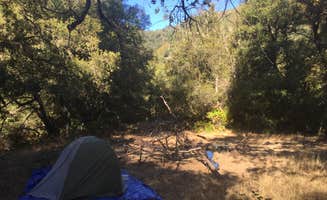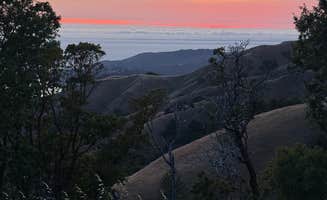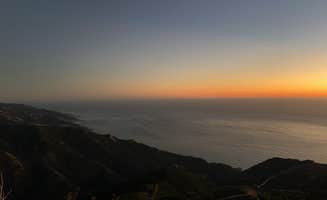Dispersed camping near Pacific Grove, California requires backpacking into remote wilderness areas of Los Padres National Forest. Most primitive campsites sit at elevations between 2,500-5,200 feet with dramatic temperature changes from day to night. The region experiences a Mediterranean climate with dry summers and relatively mild, wet winters. Limited cell service exists throughout the backcountry areas, with most campers reporting no connectivity beyond the trailheads.
What to do
Trail exploration along Carmel River: Access Bluff Camp via Los Padres Dam trailhead, following the Carmel River Trail through numerous water crossings. "The trail is pretty easy to follow, but crosses the river/creek extremely frequently. I had to cross the river about 50 times in a weekend in an out & back trip," reports Austin C. about his Bluff Camp experience.
Summit hiking: Plan a challenging day hike or overnight trek to higher elevations. The summit trail to Cone Peak involves substantial elevation gain but rewards with panoramic vistas. "The sunset was one of the best I have ever seen. There is an old outpost at the top that someone else was sleeping at to provide shelter from the wind (it was pretty vicious)," notes a backpacker about their Cone Peak adventure.
Water filtering practice: All backcountry sites require water filtration equipment as no potable water exists. Streams and springs occur along lower sections of trails but become scarce at higher elevations. "Limited water on trail. Saw some springs during the first half but none within miles of the top," warns one Cone Peak visitor.
What campers like
Solitude and quiet: Many primitive sites receive minimal visitors, particularly during weekdays. "This was a trail camp in the Ventana Wilderness along the Carmel River Trail. I got in Friday afternoon so could only hike a few miles before dark," describes Austin about his solo backpacking experience.
Multiple camping options: Several established sites exist along main trails. "Almost every hill top has a campsite, there are so many opportunities for stays. Even if you can't make it to the top, there are spots to camp all along the trail," explains Carina M. about Timber Top Camp.
Dual mountain-ocean views: The rare geography of the region provides simultaneous mountain terrain and Pacific Ocean vistas. "This might be the most beautiful camping spot I have ever stayed at. It's a ~2.8 mile hike in, but it is worth every step," notes a Timber Top Camp visitor.
What you should know
Multiple river crossings required: Accessing Bluff Camp involves crossing Carmel River repeatedly. Water levels fluctuate seasonally, potentially blocking passage during winter and early spring. One camper noted trail conditions can become "impassable at some points" due to high water.
Poison oak prevalence: The plant grows abundantly throughout all trail systems in the region. Long pants, long sleeves, and trail awareness help minimize contact. "Lots of poison oak," warns a Nacimiento Road Camp visitor about the surrounding trails.
Extended hiking distances: Most primitive sites require substantial hiking. "11.1 miles from trail head to the summit" with "5,600 ft. in elevation gain" that "took 7.5 hours total (4.5 hours moving time)" describes one backpacker about reaching Cone Peak.
Limited road access: Vehicle-accessible dispersed camping options remain extremely limited. The Nacimiento Road area provides one of the only drive-in possibilities, though road conditions vary seasonally.
Tips for camping with families
Choose shorter trail options: With children, consider Timber Top Camp's moderate 2.8-mile approach rather than longer routes. Trails to Bluff Camp, though involving multiple stream crossings, maintain relatively gentle elevation changes suitable for older children.
Pack extra layers: The coastal-mountain climate creates significant temperature variations from day to night. Mornings often begin with coastal fog while afternoons can become quite warm, requiring versatile clothing options.
Water safety planning: Stream crossings present challenges for young hikers. During spring runoff, water levels at crossings near Bluff Camp can reach knee-height or higher for adults, requiring careful monitoring with children.
Tips from RVers
Limited RV suitability: Dispersed camping in this region primarily accommodates tent camping via backpacking. No hookups, dump stations, or RV amenities exist at primitive sites.
Day-use trailhead parking: Standard RVs can typically access main trailhead parking areas, though space remains limited. These locations provide starting points for day hikes or backpacking trips to remote campsites.
Alternative base camps: Consider established campgrounds with RV facilities near Monterey or Carmel as base camps for day excursions. From there, access trailheads for day hiking the Ventana Wilderness without needing to transport camping equipment.




